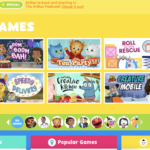“Child Safe” doesn’t mean harm free
How old’s the internet? Its forerunners, only available to the fanciest academics and governments, go back more than 54 years. The world wide web, the basis of the internet as you and I know it, is 31 years old – no spring chicken. The point is, by this time, even the slowest of slowpokes knows how to prevent the internet from posing extreme danger to kids.
Here’s the problem, looking at some of the content created for kids, it seems like the criteria for child safe is the distressingly low bar of avoiding extreme danger. If you found a berry in a bush and ate it, and it didn’t kill you, but gave you stomach upset for days, would you say it was safe to eat?
Caregivers – Don’t rely on ‘child-safe’ ratings and settings
This has probably happened to you. You’ve sat down with a child to play a game, watch a show or a music video. Then you see or hear a part of it that takes you aback and makes you think – is this really for kids? We’re quick to wipe these feelings away with sentiments like, “I watched much worse when I was younger”, and, “it’s rated for kids so maybe I’m just not with it.”
Well, so what if you’re not with it! Go with your gut. After all, ratings and child-safe designations don’t come from some infallible oracle in Oz. And you know the logic in the fact that you did worse in your childhood doesn’t hold water. Technology is moving faster than parenting can keep up and your parents probably did the best they could manage. You too can do what you believe is best even if it is different.
Your idea of kid-safe digital content probably ignores the harm in missed opportunities
So here’s the sobering truth. You may follow your own gut-approved child-safe ratings system and still unwittingly let significant harm slide through to your kids. Our sensitivities around managing kids and digital content is hyper-focused on the quantity of screen time and making sure they are kept away from content that can lead to physical or psychological danger.
Our early concerns with child-safe content were frantic and focused on keeping kids from physical harm. Then we understood that some scars are not visible and also became frantic that content leading to feelings they’re not able to process escapes their eyes and ears. That is all well and good. The problem is, seldom, if ever, is the harm from missed opportunity understood and factored in how we let our kids use screens.
Missed Opportunity – The danger that is not so clear but very present
Harm is not just about breaking bones trying to mimic a violent superhero or having nightmares from a scary movie. There are other forms of harm that are more insidious because they are so easy to miss.
Significant harm can come from missed windows to master skills
You know that saying you can’t teach an old dog new tricks? That is not quite true – you can. But it is certainly more pleasant for them to learn at the puppy stage. And some tricks, they will never be able to do quite as well as if they had learnt them as puppies.
No, we are not saying kids are just like puppies (though puppies are sooooo adorable). But you get the drift and the similarities. We can’t time travel (not yet at least) so there are some periods in a child’s life where certain skills not taught and mastered will never be grasped quite as well. So yes – there is harm to allowing that period of time to whittle away because it can never be retrieved.
The next time a child is doing something mindless for hours on end for fun. Ask yourself, is this really ‘harmless fun’? More than likely you can get in some productive content that checks both boxes of being fun and helping them attain mastery at something. Hint: Don’t reinvent the wheel. Aneta was literally built to allow you to do this.
Significant harm can come from allowing time to go to waste
Again as a species, we have not (yet) conquered the time continuum. Time will chug right along regardless of how you spend it. It seems counter intuitive that the young with many years of life ahead should be worried about opportunity cost of time. However, it is precisely because they have so many years of life ahead that we should be worried. Little Taylor discovering a joy for learning about plants may then have a lifetime to develop it into research that leads to…oh maybe, a cure for cancer. Who knows? The point is, what they do with their time is precious and more so at their young ages where they are discovering things that shape their lives journey. So yes – wasting time is harmful not just to the child but potentially to society as a whole.
We can give kids what they want – fun, engagement, intrigue – in ways that are productive to their growth.
It will probably be a long time before the official “child safe” declarations include considerations for harm related to missed opportunity. But as a parent or educator, you can include avoiding missed windows and wasted time to the bare minimum of physical and psychological danger.


